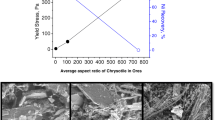Abstract
Froth flotation is a widely used process of particle separation exploiting differences in surface properties. It is important to point out that overall flotation performance (grade and recovery) is a consequence of the quality and quantity of the solid particles collected from the pulp phase, transported into the froth phase, and surviving as bubble-particle aggregates into the overflow. This work will focus on studying these phenomena and will incorporate the effects of particle hydrophobicities in the 3-phase system. Solids are classed as either hydrophilic non-sulphide gangue (e.g. silica, talc), hydrophilic sulphide (e.g. pyrite), or hydrophobic sulphide (e.g. sphalerite). Talc is a surface-active species of gangue that has been shown to behave differently from silica (frother adsorbs on the surface of talc particles). Both are common components of ores and will be studied in detail. The focus of this work is to investigate the role of solids on pulp hydrodynamics, froth bubble coalescence intensity, water overflow rate with solids present, and in particular, the interactions between solids, frother and gas on the gas dispersion parameters. The results show that in the pulp zone there is no effect of solids on bubble size and gas holdup; in the froth zone, although hydrophilic particles solely do not effect on the water overflow rate, hydrophobic particles produce higher intensity of rates on water overflow and bubble coalescence, and many be attributed to the water reattachment.
Similar content being viewed by others
References
CROZIER R, KLIMPEL R. Frothing in flotation [M]. LASKOWSKI J S, Ed. Chapter 11, New York: Gordon and Breach Science Publishers, 1989: 257–280.
FINCH J A, DOBBY G S. Column flotation [M]. New York: Pergamon Press, 1990: 343–354.
KLIMPEL R, ISHERWOOD S. Some industrial implications of changing frother chemical structure [J]. International Journal of Mineral Processing, 1991, 33: 369–381.
NESSET J E, ZHANG Wei, FINCH J A. A benchmarking tool for assessing flotation cell performance [C]// Proceedings of 44th Annual Meeting of the Canadian Mineral Processors (CIM). Ottawa, Canada: 2012: 183–209.
LEJA J, SCHULMAN J H. Flotation theory: Molecular interactions between frothers and collectors at solid-liquid-air interfaces [J]. AIME Trans, 1954, 199: 221–228.
ZHANG Wei, ZHOU X, FINCH J A. Determining independent control of dual-frother systems-gas holdup, bubble size and water overflow rate [J]. Minerals Engineering, 2012, 39: 106–116.
COMLEY B A, VERA M A, FRANZIDIS J P. Interpretation of the effect of frother type and concentration on flotation performance in an OK3 cell [J]. Mineral and Metallurgical Processing, 2007, 24(4): 243–252.
ZHANG Wei, NESSET J E, FINCH J A. Water recovery and bubble surface area flux in flotation [J]. Canadian Metallurgical Quarterly, 2010, 49(4): 353–362.
ZHANG Wei, NESSET J E, RAO S R, FINCH J A. Characterizing frothers through critical coalescence concentration (CCC95)-hydrophilic-lipophilic balance (HLB) [J]. Minerals, 2012, 2(3): 208–227.
STEVENSON P, STEVANOV C, JAMESON G J. Liquid overflow from a column of rising aqueous froth [J]. Minerals Engineering, 2003, 16(11): 1045–1053.
ALEXANDER D, FRANZIDIS J P, MANLAPIG E. Froth recovery measurement in plant scale flotation cells [J]. Minerals Engineering, 2003, 16: 1197–1203.
SEAMAN D, FRANZIDIS J P, MANLAPIG E. Bubble load measurement in the pulp zone of industrial flotation machines-A new device for determining the froth recovery of attached particles [J]. International Journal of Minerals Processing, 2004, 74(1/2): 1–13.
BARBIAN N, HADLER K, CILLIERS J J. The froth stability column: Measuring froth stability at an industrial scale [J]. Minerals Engineering, 2006, 19: 713–718.
SWEET C, VAN HOOGSTRATEN J, HARRIS M, LASKOWSKI J S. The effect of frothers on bubble size and frothability of aqueous solutions [C]// Proceedings of Complex Ores, Metallurgical Society of CIM, Montreal: 1997: 235–245.
CAPPUCCITTI F, NESSET J E. Frother and collector effects on flotation cell hydrodynamics and their implication on circuit performance [C]// Proceedings 48th Conference of Metallurgists of CIM. Sudbury: 2009: 169–180.
ZHANG Wei, KOLAHDOOZAN M, NESSET J E, FINCH J A. Use of frother with sampling-for-imaging bubble sizing technique [J]. Minerals Engineering, 2009, 22(5): 513–515.
ZHANG Wei, ZHU S, FINCH J A. Frother partitioning in dual-frother systems: Development of analytical technique [J]. International Journal of Mineral Processing, 2013, 119: 75–82.
DAHLKE R C, GOMEZ C O, FINCH J A. Operating range of a flotation cell determined from gas holdup vs gas rate [J]. Minerals Engineering, 2005, 18(9): 977–980.
GRAU R A, HEISKANEN K. Bubble size distribution in laboratory scale flotation cells [J]. Minerals Engineering, 2005, 18: 1164–1172.
QUINN J J. Exploring the effects of salts on gas dispersion and froth properties in flotation systems [D]. Montreal, Canda: McGill University, 2006.
ACUNA C, NESSET J E, FINCH J A. Impact of frother on bubble production and behavior in the pulp zone [C]// del VILLAR R, NESSET J E, GOMEZ C O, STRADING A W. Eds. Proceedings of the 6th International Copper Cobre Conference. Toronto, Canada: MetSoc CIM, 2007: 197–210.
KUAN S H, FINCH J A. Impact of talc on pulp and froth properties in F150 and 1-pentanol frother systems [J]. Minerals Engineering, 2009, 23: 1003–1009.
BANISI S, FINCH J A, LAPLANTE A R, WEBER M. Effect of solid particles on gas holdup in flotation columns: I. Measurement [J]. Chemical Engineering Science, 1995, 50(14): 2329–2334.
MELO F, LASKOWSKI J S. Fundamental properties of flotation frothers and their effect on flotation [J]. Minerals Engineering, 2006, 19(6/7/8): 766–773.
DIPPENAAR A. The destabilization of froth by solids I: the mechanisms of film rupture [J]. International Journal of Mineral Processing, 1982, 9: 1–14.
Author information
Authors and Affiliations
Corresponding author
Rights and permissions
About this article
Cite this article
Zhang, W., Finch, J.A. Effect of solids on pulp and froth properties in flotation. J. Cent. South Univ. 21, 1461–1469 (2014). https://doi.org/10.1007/s11771-014-2086-1
Received:
Accepted:
Published:
Issue Date:
DOI: https://doi.org/10.1007/s11771-014-2086-1




